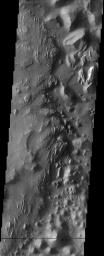Arsinoes Chaos
Caption:
At the easternmost end of Valles Marineris, a rugged, jumbled terrain known as chaos displays a stratigraphy that could be described as precarious. Perched on top of the jumbled blocks is another layer of sedimentary material that is in the process of being eroded off the top. This material is etched by the wind into yardangs before it ultimately is stripped off to reveal the existing chaos.
Note: this THEMIS visual image has not been radiometrically nor geometrically calibrated for this preliminary release. An empirical correction has been performed to remove instrumental effects. A linear shift has been applied in the cross-track and down-track direction to approximate spacecraft and planetary motion. Fully calibrated and geometrically projected images will be released through the Planetary Data System in accordance with Project policies at a later time.
Image information: VIS instrument. Latitude -7.8°, Longitude 19.1° East (340.9%deg; West). 19 meter/pixel resolution.
Background Info:
NASA's Jet Propulsion Laboratory manages the 2001 Mars Odyssey mission for NASA's Office of Space Science, Washington, D.C. The Thermal Emission Imaging System (THEMIS) was developed by Arizona State University, Tempe, in collaboration with Raytheon Santa Barbara Remote Sensing. The THEMIS investigation is led by Dr. Philip Christensen at Arizona State University. Lockheed Martin Astronautics, Denver, is the prime contractor for the Odyssey project, and developed and built the orbiter. Mission operations are conducted jointly from Lockheed Martin and from JPL, a division of the California Institute of Technology in Pasadena.
Cataloging Keywords:
| Name |
Value |
Additional Values |
| Target |
Mars |
|
| System |
|
|
| Target Type |
Planet |
|
| Mission |
2001 Mars Odyssey |
Mariner |
| Instrument Host |
Mars Odyssey |
|
| Host Type |
Orbiter |
Flyby Spacecraft |
| Instrument |
Thermal Emission Imaging System (THEMIS) |
|
| Detector |
|
|
| Extra Keywords |
Grayscale, Thermal |
| Acquisition Date |
|
| Release Date |
2003-02-26 |
| Date in Caption |
|
|
| Image Credit |
NASA/JPL/Arizona State University |
| Source |
photojournal.jpl.nasa.gov/catalog/PIA04429 |
| Identifier |
PIA04429 |

 Planetary Data System
Planetary Data System
